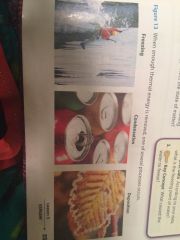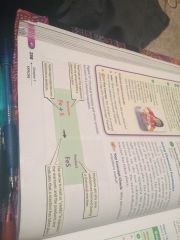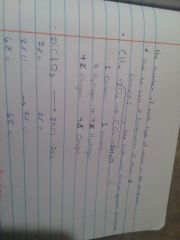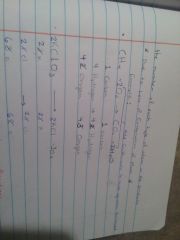![]()
![]()
![]()
Use LEFT and RIGHT arrow keys to navigate between flashcards;
Use UP and DOWN arrow keys to flip the card;
H to show hint;
A reads text to speech;
38 Cards in this Set
- Front
- Back
|
What is a physical change? |
A change in size Shape Form State of mater In which the matters identity stays the same (matter doesn't turn into something different) |
|
|
What's an example of food changing shape in a physical change? |
When you chew food you are breaking it into smaller pieces, making it a different size and shape |
|
|
How do you change state of matter in a physical change? |
Add or subtract thermal energy |
|
|
What are some examples of adding thermal energy to change the state of matter? |
Melting point -changes solid to liquid Boiling point-changes liquid to gas Sublimation-changes solid to gas |
|
|
What are some examples of removing thermal energy to change the state of matter? |
Freezing-liquid to solid Condensation-gas to liquid Deposition-gas to solid |
|
|
What are the opposite methods of adding and removing thermal energy? |
Melting point-Freezing Boiling point-Condensation Sublimation-Deposition |
|
|
Example of changes in state of matter |
See figure 11 |
|
|
What happens to the temperature when matter changes state? |
When states of matter change the temperature stays the same |
|
|
What is dissolving and is it a physical property or change? |
Dissolving Is when one substance evenly mixes into another A physical change that can be reversed |
|
|
How can dissolving be reversed using the example of salt water |
Boiling/evaporating the water will leave the salt behind |
|
|
What are some examples of removing thermal energy to change state in matter in real life? |

|
|
|
Explain the conservation of mass |
Particles in matter that are present before a physical change are the same as those present after the physical change (total mass before and after is also the same) |
|
|
Example of conservation of mass |
See fig 15 |
|
|
What is a chemical property? |
A characteristic of matter that can be observed as it changes to a different type of mater |
|
|
What are some examples of chemical properties? |
The ability of iron to rust The ability of paper to burn |
|
|
When you describe matter what do you consider? |
You consider both its physical and its chemical properties |
|
|
What is the example of chemical and physical properties in the example of a log |
Chemical : ability to burn and ability to rot
Physical : has mass volume and density |
|
|
What is a chemical change? |
A change in matter in which the substances that make up the matter change into other substances with new physical and chemical properties |
|
|
What is an example of a chemical change |
Iron changes chemically with oxygen and rust forms |
|
|
What are some signs that a chemical change may occur Do these signs ALWAYS mean that a chemical change is taking place? |
Bubbles Energy change( fire) Odor change Color change( leaves change color in fall)
No ( bubbles when water boils) |
|
|
What is the only way to prove that a chemical change has occurred |
When matter changes into a new type of matter |
|
|
What occurs during a chemical reaction? What are chemical changes often called? |
As particles in matter move, they collide with enough force, the bonded atoms that make up the particles break apart Atoms then rearrange and bond into new combinations and new substances form
Chemical reactions |
|
|
What does a chemical formula express? Ex? |
A compound H20 CO2 C6H12O6 CH4 HCL |
|
|
What do chemical equations represent? |
Represents What takes place during a chemical reaction by showing the chemical formula of each substance In the reaction |
|
|
Example of chemical equation |

Back (Definition) |
|
|
What are the reactants ? Which side are they on in a chemical equation? |
Substances you start with Left side |
|
|
What are the products? Which side are they in a chemical equation? |
Substances that are formed during reactions Right side |
|
|
Where are coefficients located in a chemical equation? What's they represent? |
Placed in front of a chemical formula
Multiplication |
|
|
Example of coefficients when CO2(4) and C6H12O6(2) How many atoms after multiplying coefficients? |
4CO2. Means 4 x CO2
4 carbon atoms. 8 oxygen atoms
2C6H12O6 Means 2 x C6H12O6
12 Carbon atoms 24 Hydrogen atoms 12 oxygen atoms |
|
|
Why must chemical equations be balanced? |
The number of each type of atom in the reactants must equal the number of each type of atom in the products due to the law of conservation of mass |
|
|
What factors make the particles in matter move faster and collide harder and more frequently? What is this doing? |

Back (Definition) |
|
|
Example of balancing chemicals equations |

Back (Definition) |
|
|
What factors make the particles in matter move faster and collide harder and more frequently (increasing the rate of chemical reactions) |
Higher temperature Concentration Surface area
|
|
|
How do higher temperatures increase the rate of chemical reactions ? |
Particles move faster when the temperature is higher |
|
|
What is concentration? How does it increase the rate of chemical reactions? |
The amount of substance in a certain volume
When concentration increases, there are more particles available to bump into and react when at least one reactant increases |
|
|
How does surface area increase the rate of chemical reactions? |
Smaller pieces have more total surface area, so more space is available for reactants to collide when at least one reactant is solid |
|
|
What is a physical property? |
Characteristics of matter that you can observe or measure without changing the identity of the matter
|
|
|
Examples of a physical property |
State of matter Mass Volume Melting/boiling point Solubility Conductivity Magnetism Density
|

